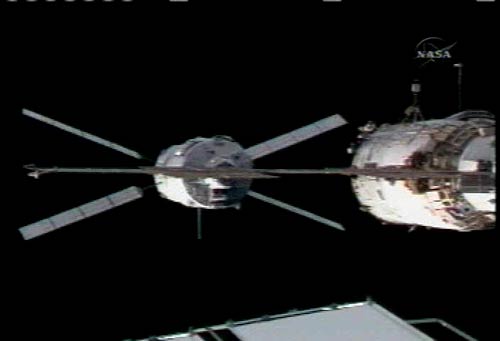European Cargo Ship Cleared to Dock at Space Station

Europe?sfirst unmanned space freighter is clear to dock at the International SpaceStation (ISS) tomorrow after acing two rendezvous tests, mission managers saidWednesday.
TheEuropean Space Agency (ESA) approved plans to dock the massive automatedcargo ship Jules Verne at the station on Thursday at 10:41 a.m. EDT (1441GMT). The first of Europe?s new fleet of Automated Transfer Vehicles (ATVs),the 21-ton spacecraft has already made two approaches to the spacestation - on Saturday and Monday, respectively - flying within about 36 feet(11 meters) at its closest approach.
"We have proven that Jules Verne's systems are safe,reliable and ready to dock to the station,? said John Ellwood, ESA's ATV projectmanager, in a Wednesday statement.
Named after the famed 19th centuryscience fiction writer, the Jules Verne ATV is a cylindrical spacecraftabout the size of a London double-decker bus. It is large enough to carry threetimes the cargo as Russia?s unmanned Progress spacecraft and is powered by foursolar panels that jut out at diagonal angles, giving the space freighter the look ofa fatX-wing fighter from ?Star Wars.?
Jules Verne launchedtoward the ISS on March 8 (ET) atop a modified Ariane 5 rocket to begin analmost four-week shakedown cruise. It is the first of at least five, andpossibly a total of seven, ATVs to haul fresh supplies to astronauts aboard thespace station.
The 32-foot (10-meter) long Jules Verne is about 15 feet (4.5meters) wide and took up a parking orbit while the crew of NASA?s space shuttleEndeavour delivered a new Japanese room and Canadian robot to the ISS last month.
The ESA has spent about 1.3 billion Euros ($1.9 billion) todevelop, build and launch the Jules Verne ATV. Flight controllers at adedicated ATV Control Center in Toulouse, France, are watching over the newspacecraft.
Get the Space.com Newsletter
Breaking space news, the latest updates on rocket launches, skywatching events and more!
Unlike Russia?s Soyuz and Progress vehicles, which can beflown manually or by remote control if their autonomous systems fail, ESA?s ATVcargo ships are not designed to be guided in by astronauts. Instead, space stationcommander Peggy Whitson and flight engineer Yuri Malenchenko have a red button that they can push to send Jules Verne back to a safedistance if it strays from its proper docking course.
But the spacecraft and its novel video-based docking system,which uses lasers to determine its position from the ISS, have performed asexpected during tests.
On March 29, Jules Verne flew within about 2 miles (3.5 km)of the station before backing away as directed. During Monday?s test, the cargoship parked itself 36 feet (11 meters) from the aft of the station?sRussian-built Zvezda service module, where it is set to dock on Thursday,before Whitson and Malenchenko successfully tested their emergency escapecommand to send the spacecraft away.
?Everyone has worked very hard to get to this point, and we havealso proven that the team on the ground is fully ready for tomorrow's firstattempt,? Ellwood said.
NASA will provide live coverage of the Jules Verne ATV?sspace station docking on NASA TV beginning at 8:00 a.m. EDT (1200 GMT). Clickhere for SPACE.com?s ISS mission coverage and NASA TV feed.
- NEW VIDEO: Europe's Special Delivery to Space Station
- NEW VIDEO: Space Freighter ?Jules Verne? Launches into Orbit
- VIDEO: Part 1: Europe's First ISS Cargo Ship, Part 2
Join our Space Forums to keep talking space on the latest missions, night sky and more! And if you have a news tip, correction or comment, let us know at: community@space.com.

Tariq is the Editor-in-Chief of Space.com and joined the team in 2001, first as an intern and staff writer, and later as an editor. He covers human spaceflight, exploration and space science, as well as skywatching and entertainment. He became Space.com's Managing Editor in 2009 and Editor-in-Chief in 2019. Before joining Space.com, Tariq was a staff reporter for The Los Angeles Times covering education and city beats in La Habra, Fullerton and Huntington Beach. In October 2022, Tariq received the Harry Kolcum Award for excellence in space reporting from the National Space Club Florida Committee. He is also an Eagle Scout (yes, he has the Space Exploration merit badge) and went to Space Camp four times as a kid and a fifth time as an adult. He has journalism degrees from the University of Southern California and New York University. You can find Tariq at Space.com and as the co-host to the This Week In Space podcast with space historian Rod Pyle on the TWiT network. To see his latest project, you can follow Tariq on Twitter @tariqjmalik.









